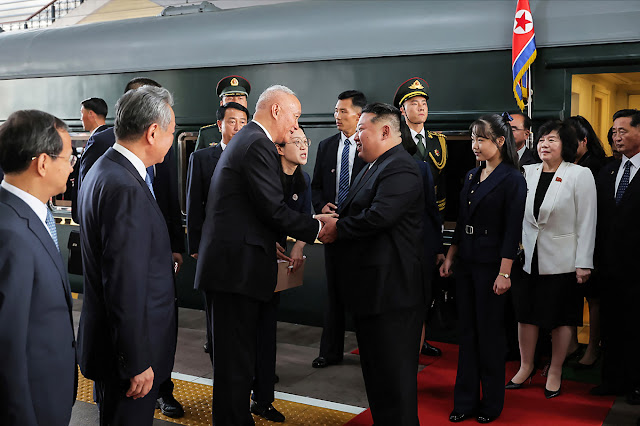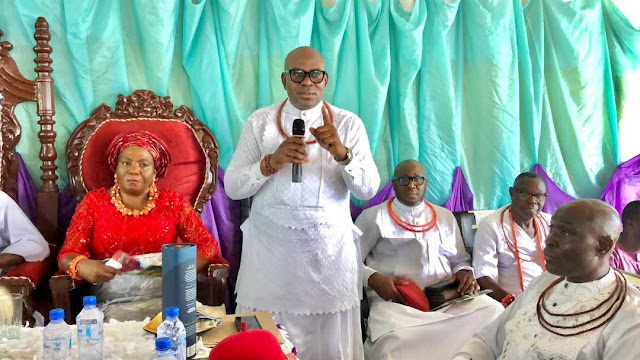On September 3, 2025, a significant milestone in North Korean diplomacy and leadership unfolded as Kim Ju Ae, the young daughter of North Korean Supreme Leader Kim Jong Un, made her first international appearance during a state visit to China. This historic event, reported by various international media outlets and initially covered by Linda Ikeji’s Blog, marks a rare and carefully orchestrated moment in North Korea’s tightly controlled public narrative. At an estimated age of 12, Kim Ju Ae’s presence on the global stage has sparked widespread speculation about her role in the future of the reclusive nation, the dynamics of North Korea-China relations, and the broader geopolitical implications of this debut.
The trip, which saw Kim Ju Ae accompany her father to Beijing, was framed as a diplomatic engagement aimed at reinforcing the longstanding alliance between North Korea and China. While Kim Jong Un has frequently traveled to China to meet with President Xi Jinping, the inclusion of his daughter in this high-profile visit signals a potential shift in how the Kim dynasty is positioning itself both domestically and internationally. This article delves into the details of Kim Ju Ae’s debut, the historical context of North Korea’s leadership succession, the significance of the China-North Korea relationship, and the broader implications for global politics.
The Emergence of Kim Ju Ae
Kim Ju Ae, believed to be born around 2013, has long been a figure shrouded in mystery, much like the inner workings of North Korea itself. The Kim family has maintained a cult of personality since the founding of the Democratic People’s Republic of Korea (DPRK) in 1948, with each successive leader—Kim Il-sung, Kim Jong-il, and now Kim Jong Un—carefully crafting an image of divine and infallible leadership. Kim Ju Ae’s public appearances have been rare, limited to carefully curated domestic events, such as military parades and cultural celebrations in Pyongyang. Her presence at these events, often alongside her father, has fueled speculation that she is being groomed as a potential successor to the Kim dynasty, a notion that her international debut in China only intensifies.
The decision to introduce Kim Ju Ae to the global stage during a trip to China is significant for several reasons. First, it marks a departure from the traditional secrecy surrounding the Kim family’s younger members. Unlike her father, who was not publicly acknowledged as Kim Jong-il’s heir until his late 20s, Kim Ju Ae is being presented to the world at a much younger age. This early exposure suggests that North Korea is taking deliberate steps to prepare its citizens—and the international community—for a future in which Kim Ju Ae may play a prominent role.
Second, the choice of China as the setting for her debut is laden with symbolic and strategic importance. China has been North Korea’s most significant ally since the Korean War (1950–1953), providing economic, military, and political support to the DPRK in the face of international isolation. By bringing Kim Ju Ae to China, Kim Jong Un is signaling continuity in this critical relationship while also introducing the next generation of North Korean leadership to Beijing’s political elite.
The China Visit: A Diplomatic Milestone
According to reports, the visit to China was a carefully planned affair, with Kim Jong Un and his daughter attending a series of high-level meetings and ceremonial events in Beijing. While the exact details of the trip remain limited—consistent with North Korea’s opaque approach to public relations—state media from both countries highlighted the strengthening of bilateral ties. Chinese President Xi Jinping reportedly welcomed Kim Ju Ae warmly, a gesture that underscores Beijing’s willingness to engage with the next generation of North Korean leadership.
The agenda of the visit likely included discussions on trade, security, and regional stability, topics that have long dominated North Korea-China summits. North Korea relies heavily on China for economic support, including food, fuel, and other essential goods, particularly in the face of stringent international sanctions imposed due to its nuclear weapons program. In return, China views North Korea as a strategic buffer against U.S. influence in the region, particularly given the presence of American troops in South Korea and Japan.
Kim Ju Ae’s presence during these discussions, even if symbolic, sends a powerful message about the Kim dynasty’s long-term vision. By showcasing his daughter in such a high-stakes diplomatic setting, Kim Jong Un is not only reinforcing the legitimacy of his family’s rule but also signaling to China that the DPRK’s leadership structure will remain stable and predictable in the years to come. This is particularly important given concerns about Kim Jong Un’s health, which have periodically surfaced in international media, raising questions about succession in the event of his untimely death.
Historical Context: The Kim Dynasty and Succession
To fully appreciate the significance of Kim Ju Ae’s international debut, it is essential to understand the historical context of leadership succession in North Korea. The DPRK is one of the few remaining hereditary dictatorships in the world, with power passing from Kim Il-sung, the country’s founder, to his son Kim Jong-il, and then to his grandson Kim Jong Un. This dynastic succession is a cornerstone of North Korea’s political system, underpinned by a propaganda machine that portrays the Kim family as near-mythical figures destined to lead the nation.
Kim Il-sung, who ruled from 1948 until his death in 1994, established the foundations of the DPRK’s socialist system and cult of personality. His son, Kim Jong-il, was carefully groomed as his successor, making his first major public appearance in the 1980s before formally taking power. Kim Jong Un, in turn, was introduced to the public in 2010, just two years before his father’s death in 2011. Each transition has been meticulously planned to ensure continuity and prevent factionalism within the regime.
Kim Ju Ae’s emergence, however, introduces a new dynamic. Unlike her predecessors, she is being presented to the public at a much younger age, and as a female heir in a deeply patriarchal society. While North Korea’s propaganda has occasionally highlighted the contributions of women, such as Kim Il-sung’s mother, Kang Pan-sok, the prospect of a female leader is unprecedented. Some analysts speculate that Kim Ju Ae’s prominence may be a strategic move to soften North Korea’s image internationally, presenting a younger, more relatable face of the regime. Others argue that her role may be ceremonial, with real power potentially passing to other family members, such as Kim Jong Un’s sister, Kim Yo-jong, who has emerged as a key figure in the regime.
The Role of China in North Korea’s Future
China’s role in Kim Ju Ae’s debut cannot be overstated. As North Korea’s closest ally, China has a vested interest in the stability of the DPRK’s leadership. The two countries share a 1,400-kilometer border, and China has historically viewed North Korea as a critical geopolitical ally in countering U.S. influence in East Asia. The relationship, however, has not been without tensions. China has occasionally expressed frustration with North Korea’s provocative actions, such as its nuclear tests and missile launches, which have complicated Beijing’s efforts to maintain regional stability.
The inclusion of Kim Ju Ae in the China visit suggests that Beijing is being invited to play a role in legitimizing the next generation of North Korean leadership. This is particularly significant given the challenges facing North Korea’s economy and society. Decades of mismanagement, coupled with international sanctions, have left the country in a state of chronic economic hardship. Food shortages, energy crises, and limited access to modern technology have created significant challenges for the regime, which relies on propaganda and repression to maintain control.
China’s economic support has been a lifeline for North Korea, providing everything from food aid to investment in infrastructure projects. In recent years, China has also facilitated informal trade across the border, allowing North Korean markets to access goods that would otherwise be unavailable due to sanctions. By bringing Kim Ju Ae to China, Kim Jong Un is likely signaling his commitment to maintaining this economic lifeline while also ensuring that Beijing remains invested in the Kim family’s rule.
Geopolitical Implications
Kim Ju Ae’s debut comes at a time of heightened geopolitical tension in East Asia. The United States, South Korea, and Japan have intensified their military cooperation in response to North Korea’s ongoing nuclear and missile programs. In 2024, the U.S. and South Korea conducted their largest-ever joint military exercises, prompting sharp condemnation from Pyongyang. Meanwhile, China and Russia have deepened their own strategic partnership, positioning themselves as counterweights to Western influence in the region.
In this context, Kim Ju Ae’s appearance in China can be seen as part of a broader effort to strengthen the China-North Korea-Russia axis. By presenting his daughter as a future leader, Kim Jong Un is signaling to both allies and adversaries that the DPRK remains a stable and enduring player in global politics. This is particularly important as North Korea seeks to navigate the complex dynamics of great power competition, balancing its reliance on China with its desire to assert sovereignty and independence.
For the United States and its allies, Kim Ju Ae’s debut raises questions about the future of North Korea’s nuclear ambitions. The DPRK has shown no signs of abandoning its nuclear weapons program, which it views as essential to its survival in the face of perceived Western hostility. If Kim Ju Ae is indeed being groomed as a successor, her early exposure to international diplomacy suggests that she will inherit a regime committed to maintaining its nuclear arsenal. This could complicate efforts to negotiate denuclearization, a goal that has eluded successive U.S. administrations.
Domestic Implications in North Korea
Within North Korea, Kim Ju Ae’s international debut is likely to have significant domestic implications. The regime’s propaganda machine has already begun to elevate her status, portraying her as a symbol of the Kim family’s enduring legacy. State media has described her as a “beloved daughter” and a “guiding star” for the nation, language that mirrors the rhetoric used to describe past leaders. By presenting her to the public at such a young age, the regime is likely seeking to build loyalty and familiarity among North Koreans, particularly the younger generation.
However, the prospect of a female leader in North Korea’s male-dominated political system raises questions about how Kim Ju Ae will be received by the country’s elite. The DPRK’s military and party leadership are overwhelmingly male, and any transition to a female leader would require careful management to avoid internal dissent. Kim Yo-jong’s prominence in recent years suggests that the Kim family is willing to challenge traditional gender norms, but the extent to which this will translate into broader acceptance remains uncertain.
Moreover, Kim Ju Ae’s youth poses unique challenges. At 12 years old, she is far from assuming any formal leadership role, and her father’s relatively young age (in his early 40s) suggests that any succession is likely decades away. In the interim, the regime will need to navigate the delicate task of preparing her for leadership while maintaining the loyalty of other potential contenders, including Kim Yo-jong and other members of the Kim family.
The Role of Propaganda and Public Perception
North Korea’s propaganda apparatus will play a critical role in shaping public perception of Kim Ju Ae. The regime has a long history of using state-controlled media to craft narratives that reinforce the legitimacy of the Kim dynasty. Kim Ju Ae’s appearances at domestic events, such as the 2023 New Year’s celebrations and military parades, have already been heavily publicized, with images of her standing alongside her father dominating state media. Her trip to China will likely be portrayed as a triumph of North Korean diplomacy, further solidifying her status as a figure of national pride.
Internationally, however, her debut is likely to be met with a mix of curiosity and skepticism. Analysts and policymakers will closely scrutinize her role, looking for clues about the future direction of North Korea’s policies. Some may view her as a potential reformer, given her exposure to international settings at a young age. Others may see her as a continuation of the Kim dynasty’s authoritarian legacy, with little prospect for meaningful change.
The Broader Context of North Korea’s Diplomacy
Kim Ju Ae’s debut must also be understood within the broader context of North Korea’s diplomatic strategy. The DPRK has long used high-profile international engagements to assert its relevance on the global stage. Kim Jong Un’s summits with U.S. President Donald Trump in 2018 and 2019, as well as his meetings with Chinese and Russian leaders, were designed to project strength and legitimacy. By including his daughter in the China visit, Kim Jong Un is extending this strategy to the next generation, ensuring that the Kim dynasty remains a central feature of North Korea’s diplomatic identity.
The timing of the visit is also significant. In recent years, North Korea has faced growing challenges, including the economic fallout from the COVID-19 pandemic, which led to prolonged border closures and a deepening humanitarian crisis. By engaging with China, Kim Jong Un is likely seeking to secure additional support to address these challenges while also signaling to the international community that North Korea remains a resilient and unified state.
Conclusion
Kim Ju Ae’s global debut during the September 2025 trip to China represents a pivotal moment in North Korea’s political history. As the daughter of Kim Jong Un, her emergence on the international stage signals the regime’s intent to prepare for a future leadership transition while reinforcing its alliance with China. The event underscores the enduring importance of the Kim dynasty in North Korea’s political system and raises important questions about the country’s future trajectory.
For now, Kim Ju Ae remains a figure of intrigue, her role carefully choreographed by a regime that thrives on secrecy and control. Whether she will eventually assume the mantle of leadership or serve as a symbolic figurehead remains to be seen. What is clear, however, is that her debut marks a new chapter in North Korea’s ongoing effort to navigate a complex and rapidly changing global landscape. As the world watches, the young heiress to the Kim dynasty will undoubtedly remain a focal point of speculation and analysis for years to come.







